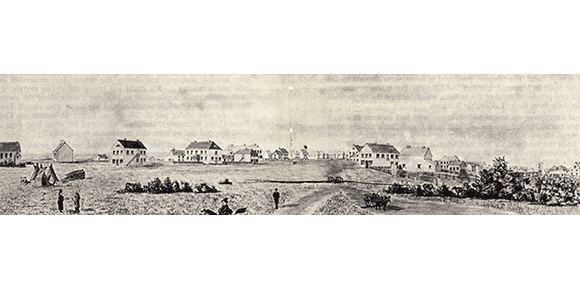by Bruce Cherney (part 4)
“Dutch George” Emmerling’s stranglehold on the liquor trade in Winnipeg was brief, as competition arose from newcomers who wanted to carve out their own share of the saloon business in the community.
Hugh F. “Bob” Olone first settled in Portage la Prairie in 1865 and opened a trading store with fellow Americans and Civil War veterans Jim Clewett and Bill Salmon. A.C. Garrioch, who studied theology between 1869 and 1870 at St. John’s College in the Red River Settlement, in his 1933 book, The Correction Line, said the partners arrived in Portage and began their business with a barrel containing 200 gallons of whiskey.
The trio got into a dispute over whiskey at their store with an armed party of 28 Ojibway on May 28, 1866. Once the battle ended, the Americans set off for Fort Garry to obtain medical treatment for their wounded companions. Salmon died of his gun shot wounds, Clewett survived a severe knife wound, although nothing further is heard about him, and Olone stayed in Winnipeg. There is no record of Olone’s employment or actions in the community until the September 29, 1868, Nor’Wester reported he had broken his leg when he fell from a horse.
In 1868, John Lennon became a partner with Olone in the saloon business, but an April 10, 1869, announcement in the Nor’Wester stated the partnership had been dissolved. His next partner was R.D. Campbell as reported from January to March 1870 in the New Nation, but the partnership lasted for only a few months. An advertisement in the January 28, 1870, New Nation announced that Olone and William “Billy” Cosgrove were “fitting up the building (then a warehouse) between Emmerling’s Hotel and Mr. McKenney’s store for a Saloon.” A July 8, 1870, advertisement in the New Nation announced that John Lennon had opened a “first class saloon, between George Emmerling’s and Henry McKenney’s” along Main Street.
According to George B. Winship, who lived in Red River during this period and was the printer for the Nor’Wester, which became the New Nation when taken over by Louis Riel’s provisional government, Lennon was “tall and muscular, an expert boxer,” and soon won a reputation for using his fists “in the interest of law and order — that is to say, the tough element stood in awe of him and his fists did more sometimes to preserve order than the efforts of the police” (article in the Free Press on February 18, 1928).
John Lennon (nicknamed Lemons) soon left Winnipeg to set up shop as a saloon-keeper in Pembina, Dakota Territory (later North Dakota). In keeping with the tradition of frontier justice he earlier dealt out in Winnipeg, Lennon became the sheriff of Pembina County.
By June 1871, Cosgrove went into business with Edward Lennon as co-owners of the Red Saloon, which was announced in an advertisement in Le Metis on June 15, 1871.
The St. Paul Daily Pioneer reported on March 7, 1871, that Hugh Olone was killed by a blow to the head from a pistol during a dance at Pembina in early January that year. Olone had relocated to the U.S. in fear of retaliation by the Ontario militiamen — primarily Protestant Orangemen with an anti-French, anti-Métis and anti-Catholic mantra — who came to Red River with the Colonel Garnet Wollesey expedition and were set upon avenging the execution of Thomas Scott. Olone had served in the Convention of 24 and was a member of the Legislative Assembly of Assiniboia which unanimously approved the Manitoba Act; thus, giving local consent for the new province’s entry into the Canadian Confederation.
There’s no evidence Olone participated in the execution of Scott. Still, some historians believe he was assassinated by militiamen bent upon vengeance.
Onis Monchamp, who came west from Quebec, also had a saloon in a small building on the south side of Post Office Street (now Lombard), which at first was only fitted with a rough counter and a bench.
Also in competition with “Dutch George” Emmerling was Charles Garrett, who built a boarding house and saloon behind the Red River Hall in 1869. He was a member of the Canadian Party’s ill-fated and rather infamous volunteer militia in the Red River Settlement and was among those imprisoned by Riel.
Begg and Nursey described Garrett as a “hotel-keeper, lawyer, doctor, stump orator and goodness knows what else” who “made himself notorious.” He died in 1873.
Begg and Nursey said Emmerling could at times be “rather overbearing,” although “he was credited with a kind heart, and his peculiarities were therefore overlooked.
They said Emmerling “soon built an addition to his hotel” that “with some alterations and improvements, was the ‘Emmerling Hotel’ of ’69 and ’70.”
“The ‘hotel,’ then the leading one in the settlement, was the centre of attraction for all, and if its walls could but speak they (sic) would a tale unfold that would recall many pleasant and unpleasant memories of those halcyon days,” reported the Manitoba Free Press on May 31, 1890, when the hotel was about to be demolished.
(Next week: part 5)



